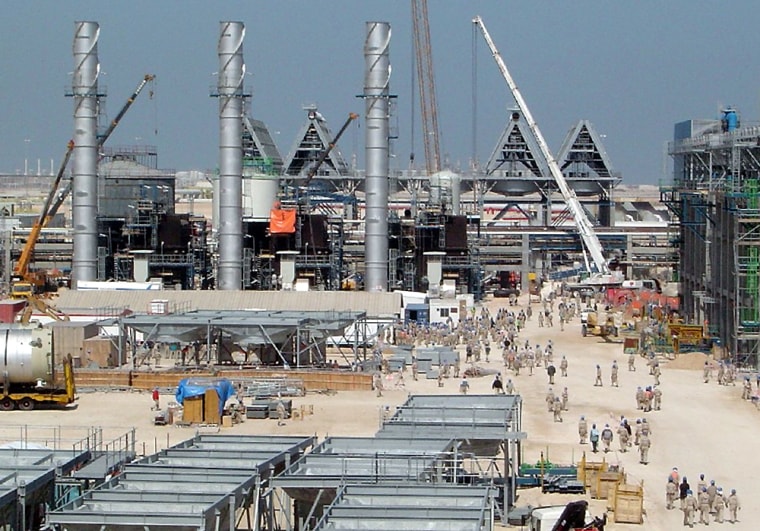The rat’s nest of pipes and columns snaking across the desert harbors a secret process that will use cobalt to turn natural gas into a powerful, clean-burning diesel fuel.
By next year, rulers of this tiny desert sheikdom hope, these gas-to-liquids (GTL) reactors under construction will bring in billions of dollars while clearing big city smog belched by trucks and buses.
Petroleum experts who have sniffed vials of gin-clear GTL diesel speak of it with reverence.
“It’s a beautiful product,” says Jim Jensen, a Massachusetts-based energy economist. “The kerosene smells like perfume.”
In all, some $20 billion has been committed to build an unprecedented array of clean diesel plants in this Gulf shore industrial park.
ExxonMobil's biggest investment — ever
Those chipping in include oil titans Royal Dutch/Shell Group, ChevronTexaco Corp. and ExxonMobil Corp., which is making a $7 billion bet on GTL, the largest investment in the corporate history of America’s largest company.
Smaller plants in Malaysia, South Africa and the United States have proved the technology works, but none is nearly as large as those planned here. In a few years, says Andy Brown, who heads Shell’s office in Qatar, the country will be “the GTL capital of the world.”
“This really is where GTL will come of age, where the industry will be born,” he said.
By 2011, the Qatar plants should be producing 300,000 barrels of liquid fuels and other products daily. The largest GTL plant now producing is Shell’s plant in Bintulu, Malaysia, churning out 14,700 barrels per day.
The investments amount to a big gamble on a clean alternative to pollutant-rich crude oil, based on an obscure “synthetic fuel” process developed to make fuel from coal in 1920s Germany.
Like Qatar’s headlong rush to produce liquefied natural gas, the ruling sheiks here are pushing GTL as an idea whose time has come.
The clean-burning fuel, with almost none of the smelly sulfur soot belched by engines firing on conventional diesel, appears tailor-made for countries looking to reduce emissions in line with the Kyoto Protocol on global warming.
Faisal al-Suwaidi, chief executive of Qatar Liquefied Gas Co., said he’s gotten interest from Japan, Canada, Korea, Europe and the United States, the world’s largest polluter. Although Washington has refused to sign the Kyoto protocols, state and local caps on emissions are pushing refiners to clean up diesel.
Complying with Kyoto’s strictures “is agenda item No. 1 when we visit countries like Japan,” al-Suwaidi said over coffee in his office in the Qatari capital, Doha. “This is the product for them. This is green diesel.”
Huge sulfur benefits
As far as carbon emissions go, green diesel appears to offer only a modest dent, partly because natural gas contains less carbon than oil-based diesel to begin with. The big difference is in sulfur.
Sulfur emissions from diesel engines cause as many as 10,000 deaths a year among Americans with heart and lung ailments, said William Becker, who represents state and local air pollution control agencies in the United States.
“It’s a matter of life and death,” Becker said. “And the solution depends on removing the sulfur.”
Emissions can be cut further by adding better filters that remove up to 90 percent of remaining particulates, said Richard Kassel, a fuels expert at the Natural Resources Defense Council in New York. Sulfur-laden diesel gums up these finer filters, he said.
“Clean fuels open the door to the most advanced emission controls,” Kassel said.
Tests of GTL fuel are under way in several countries. Shell is already selling the fuel in Thailand, The Netherlands, Greece and Germany, charging slightly more than its oil-based diesel. In Europe, Shell calls the fuel V-Power Diesel.
Environmentalists like Kassel caution that GTL fuel is most attractive when high oil prices make it competitive. The fuel will probably see most of its smog-cutting in developing countries where emissions standards will require better filters.
Likely to be blended with diesel
“It’s going to be a very important blending stock but the idea that it’s going to compete with crude oil is overstating the case,” Jensen said. “It sort of cuts down on the use of crude but it’s not going to massively change things.”
GTL diesel from Sasol Chevron, the South African-American joint venture that is a 49 percent shareholder in the first Qatari GTL plant, will surge onto the market next year and could wind up as a niche fuel that powers fleets of city buses and trucks, company spokesman Malcolm Wells said.
More likely, says economist Jensen, the clean fuel will be blended with crude-oil diesel to lower sulfur emissions into compliance with tightening standards in several countries.
The economics of GTL make sense, experts say, when it’s produced on a large scale and with a cheap source of natural gas. And Qatar, a Connecticut-sized thumb on the Arabian peninsula, is perhaps the world’s best source of cheap gas. It sits on a bubble containing 10 percent of the world’s known gas reserves, conveniently gathered in the planet’s largest reservoir.
By 2011, Qatar hopes three ventures will convert natural gas into more than 300,000 barrels per day of liquids, most of that diesel fuel, but also including naphtha, liquid petroleum gas and lubricating oil. That much synthetic diesel won’t cut into the current market for oil-based diesel — 13 million barrels a day — but it might help clear some skylines.
The fuel will be sell for more than conventional diesel, and is hugely profitable with current oil prices above $50 a barrel. But Shell will still profit if oil drops to $20, Brown said.
ExxonMobil aims to produce 155,000 barrels per day by 2011, said Wayne Harms, Exxon’s chief in Qatar.
“We have a lot of money invested here. We’re going to invest a lot more,” he said. Exxon counts investments in some 200 countries, and Qatar “will be one of our top countries by the end of the decade,” he said.
